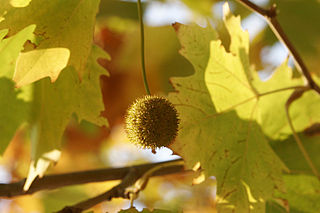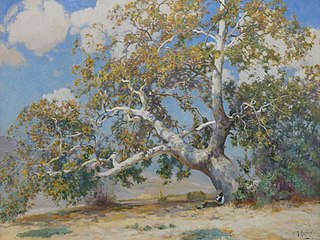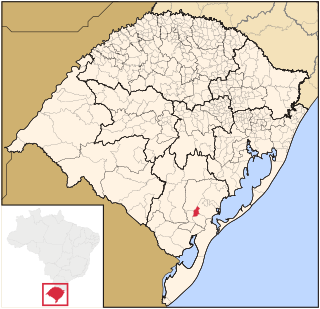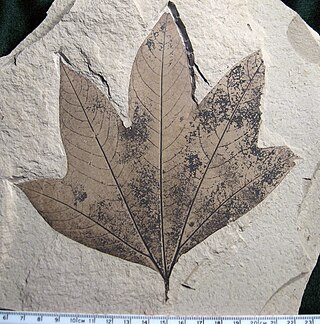Sycamore is a name which has been applied to several types of trees, but with somewhat similar leaf forms. The name derives from the Ancient Greek σῡκόμορος meaning 'fig-mulberry'.

Platanaceae, the plane family, is a family of flowering plants in the order Proteales. The family consists of only a single extant genus Platanus, with twelve known species. The plants are tall trees, native to temperate and subtropical regions of the Northern Hemisphere. The hybrid London plane is widely planted in cities worldwide.

Platanus is a genus consisting of a small number of tree species native to the Northern Hemisphere. They are the sole living members of the family Platanaceae.

Platanus orientalis, the Oriental plane, is a large, deciduous tree of the Platanaceae family, growing to 30 m (98 ft) or more, and known for its longevity and spreading crown. In autumn its deep green leaves may change to blood red, amber, and yellow.

Platanus × hispanica, the London plane or hybrid plane, is a tree in the genus Platanus. It is often known by the synonym Platanus × acerifolia, a later name. It is a hybrid of Platanus orientalis and Platanus occidentalis.

Platanus occidentalis, also known as American sycamore, American planetree, western plane, occidental plane, buttonwood, and water beech, is a species of Platanus native to the eastern and central United States, the mountains of northeastern Mexico, extreme southern Ontario, and extreme southern Quebec. It is usually called sycamore in North America, a name which can refer to other types of trees in other parts of the world; in the United Kingdom, for example, the name syacamore typically refers to Acer pseudoplatanus. The American sycamore is a long-lived species, typically surviving at least 200 years and likely as long as 500–600 years.

Platanus racemosa is a species of plane tree known by several common names, including California sycamore, western sycamore, California plane tree, and in North American Spanish aliso. Platanus racemosa is native to California and Baja California, where it grows in riparian areas, canyons, floodplains, at springs and seeps, and along streams and rivers in several types of habitats. It can be found as far north as Tehama and Humboldt counties.

Gracillarioidea is a large superfamily containing four families of insects in the order Lepidoptera. These generally small moths are miners in plant tissue as caterpillars. There are about 113 described genera distributed worldwide, the most commonly encountered of which are leaf miners in the family Gracillariidae.

Gracillariidae is an important family of insects in the order Lepidoptera and the principal family of leaf miners that includes several economic, horticultural or recently invasive pest species such as the horse-chestnut leaf miner, Cameraria ohridella.

Morro Redondo is a Brazilian municipality in the southern part of the state of Rio Grande do Sul. The population is 6,589 in an area of 244.65 km². It is located 35 km (21.75 mi) from Pelotas.

Phyllonorycter platani is a moth of the family Gracillariidae. The moth is found in Europe, the Near East and the eastern Palearctic realm, as well as California in the United States.

Platanus wrightii, the Arizona sycamore, is a sycamore tree native to Arizona and New Mexico with its range extending south into the Mexican states of Sonora, Chihuahua, and Sinaloa.

Çınar incident is the name of a 17th-century rebellion in the Ottoman Empire. It is also sometimes known as "The Event of the Wakwak", named after a mythical tree on which human beings grew, as an analogy to the corpses hung from trees in the aftermath of the rebellion.

Gracillariinae are a subfamily of moths which was described by Henry Tibbats Stainton in 1854.
Charadrus or Charadros was a town on the coast of ancient Cilicia, between Platanus and Cragus, according to the Stadiasmus. Strabo, who writes it Χαραδροῦς, describes it as a fort with a port below it, and a mountain Andriclus above it. It is described by Francis Beaufort "as an opening through the mountains with a small river." The mountain is mentioned in the Stadiasmus under the name Androcus.

Macginitiea is an extinct genus in the family Platanaceae ranging from the Late Paleocene to Late Eocene of North America, known from the Clarno Formation of central Oregon and other areas ranging from California to Texas and North to Alberta. The genus is strictly used to describe leaves, but has been found in close association with other fossil platanoid organs, which collectively have been used for whole plant reconstructions. Macginitiea and its associated organs are important as together they comprise one of the most well-documented and ubiquitous fossil plants, particularly in the Paleogene of North America.
Platanus or Platanous was a town on the coast of Cilicia Aspera, west of Anemurium. The Stadiasmus Maris Magni places Platanus 350 stadia from Anemurium, which is most likely incorrect. William Smith posited a distance of 150 stadia.
Rygmanoi was a town on the coast of ancient Cilicia, east of Anemurium at the mouth of the Orymagdos River.
In Greek mythology, Platanus is the daughter of the Thessalian king Aloeus and the sister of the Aloadae giants, who attacked the gods. Platanus was said to be as big as her brothers. Her brief tale survives in the chronicles of a Byzantine scholar of the twelfth century, Nicephorus Basilacius.











